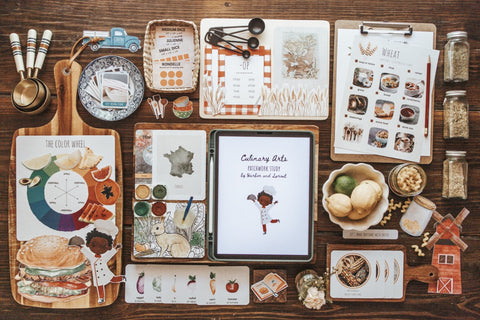
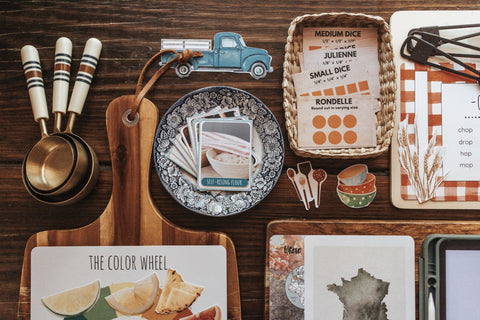
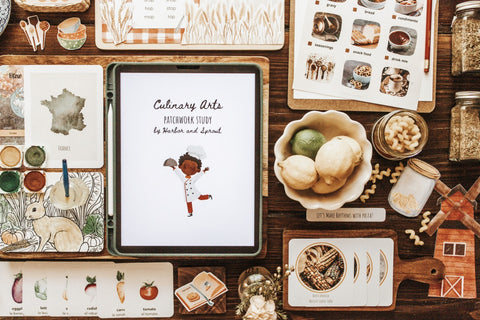
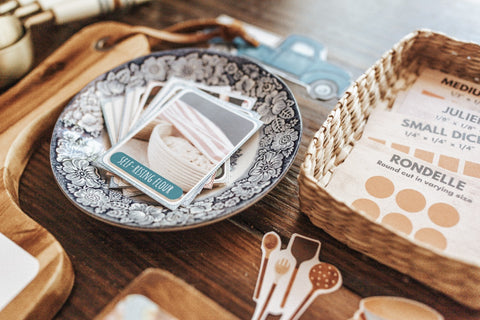
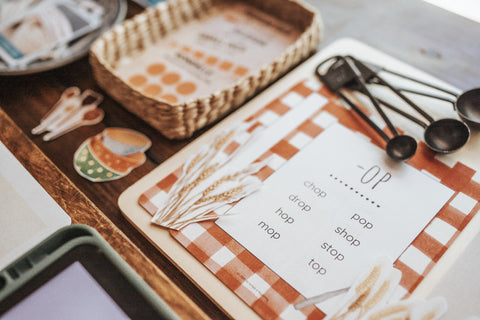
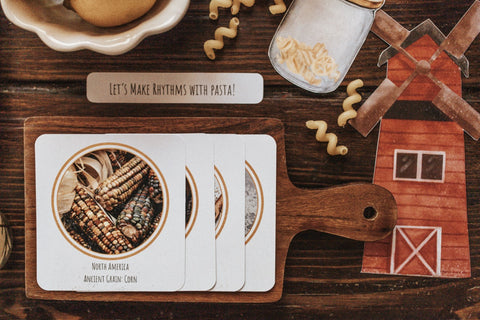
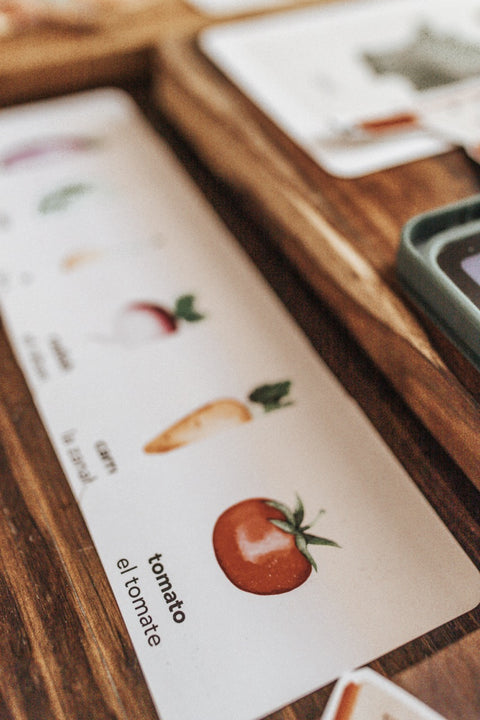
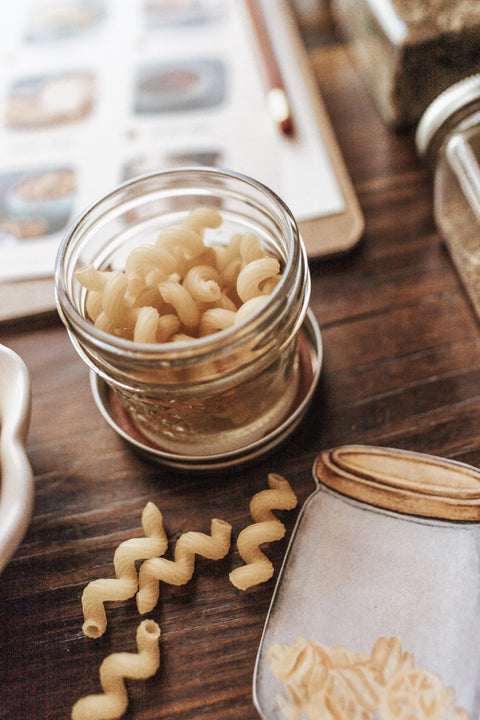
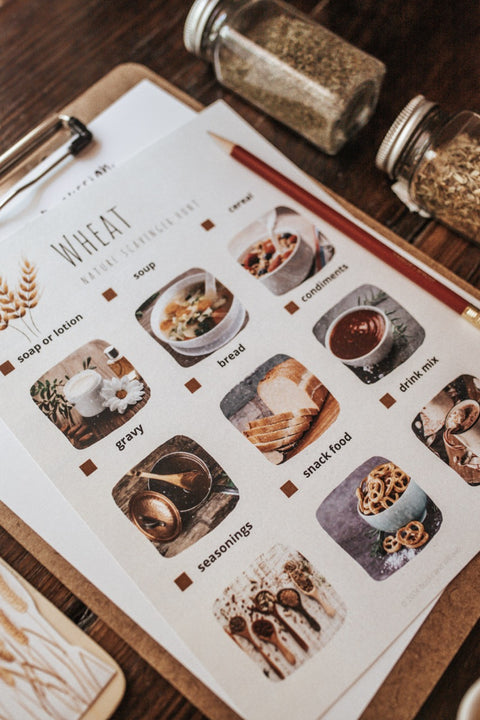
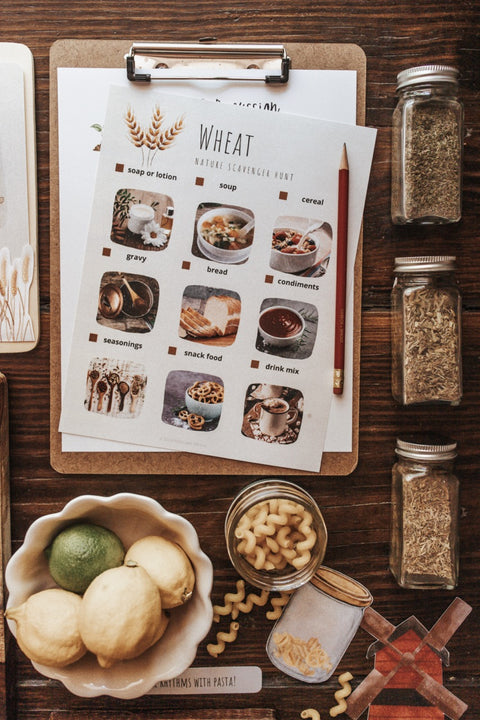
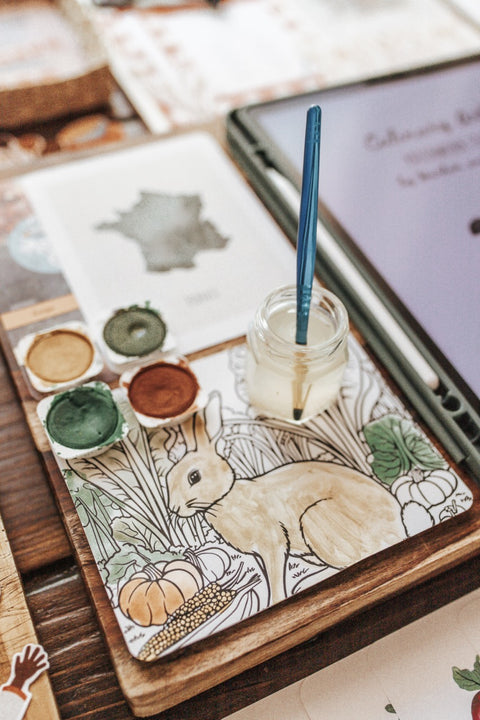
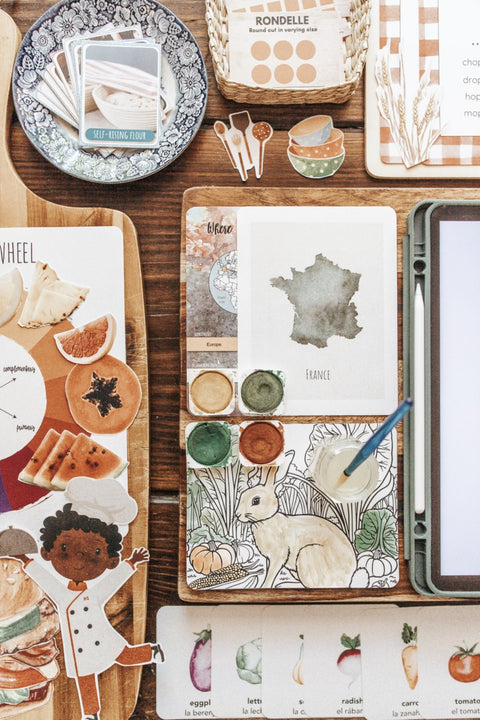
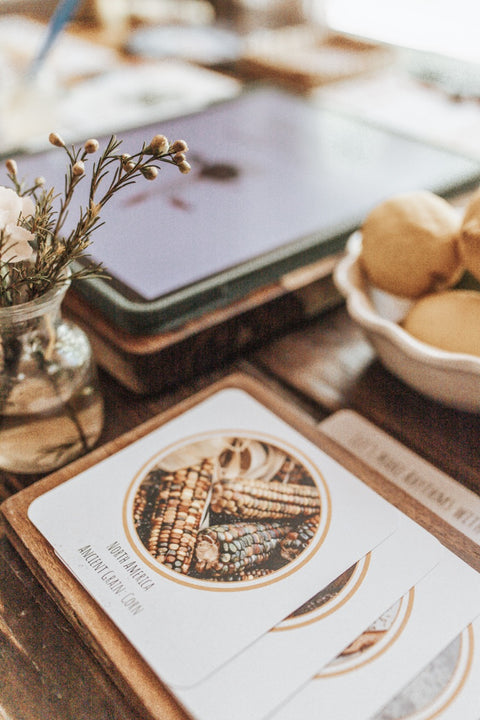
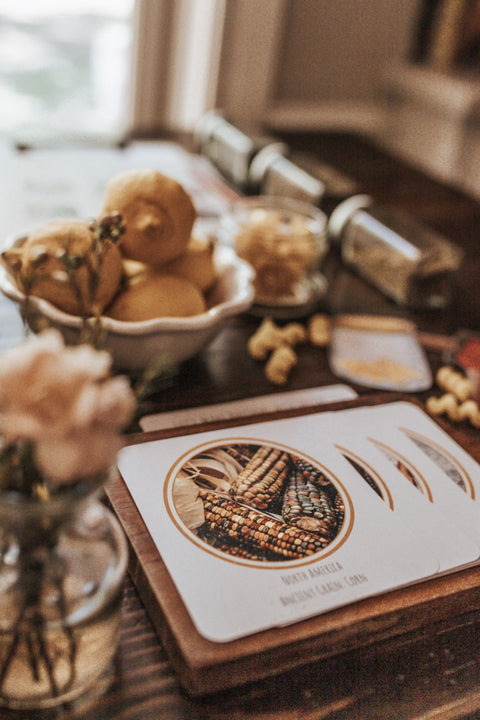
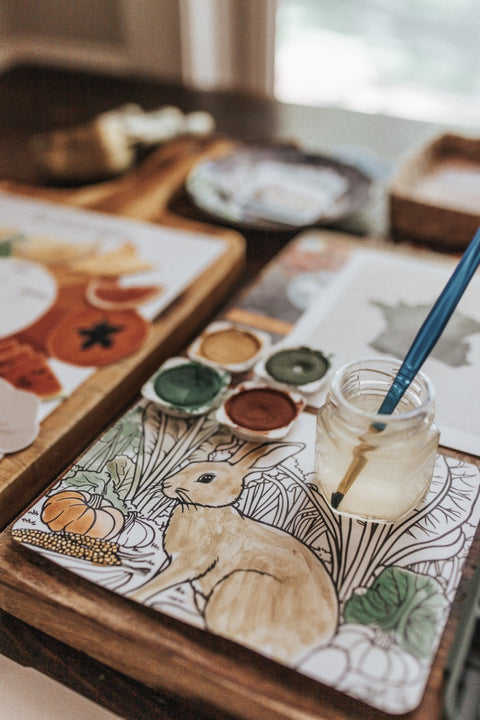
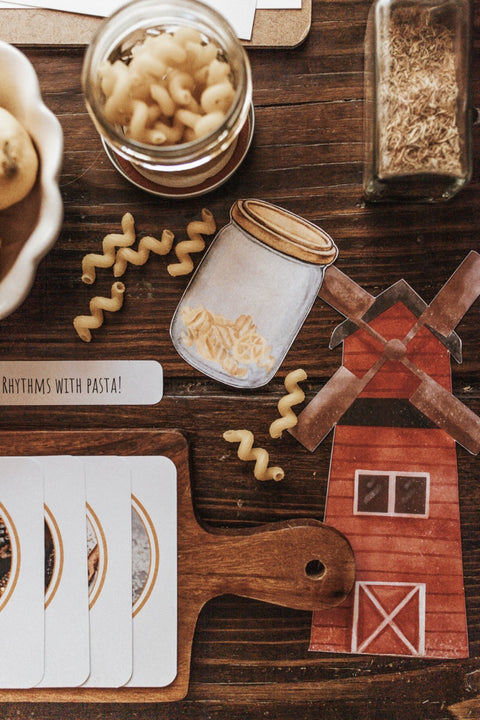
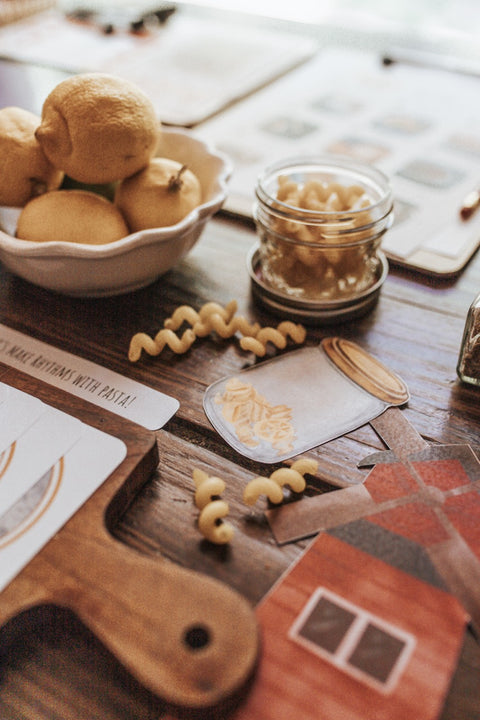
Harbor and Sprout
Culinary Arts Patchwork Study
Welcome to the Harbor + Sprout Culinary Arts Patchwork Study, the April 2025 release of our original elementary-level homeschool unit study curriculum. This unit study features 4 weeks of lesson plans and materials covering all 9 of our core subjects and a playful supplemental section of thematic activities. This unit study is meant for use by children ages 3-12.
Click here to download a free sample of a Patchwork Study.
This unit is delivered via a secure link as a digital download.
CONTENT:
Handbook
Daily, weekly, and monthly planning pages
Book list including stories, poems, and field guides with recommended ages, subject correspondence, and brief summaries for each title
Scope and Sequence
Family read aloud with discussion guide and recipe
Character kit- new monthly character illustrated by Stephanie Groves to act as your guide through the unit
Science
Lesson 1: What are the Culinary Arts?- In this lesson, you will learn knife anatomy, skills, and safety as you make a salsa and mirepoix (a traditional combination of onion, celery, and carrots). You will explore food preparation, the courses of a meal, and kitchen safety.
Lesson 2: Can you use Science to Cook?- In this lesson, you will learn how to make a Quiche Lorraine, test cooking carrots, how to make ice cream in a bag, and how to bake ice cream (yes, bake!) You will explore three ways to cook with heat and three states of matter.
Lesson 3: Does Cooking Have Chemistry?- In this lesson, you will brew fizzy lemonade, turn sugar into caramel, turn milk into cheese, and experiment with browning fruit. You will explore chemical changes, what happens to proteins when exposed to heat, and emulsification.
Lesson 4: Is There Science in Spice?- In this lesson, you will learn about spices while making spice blends and learn about and made meat marinades. You will discover the five types of flavors, where spices come from, and what chemical makes peppers hot.
Nature Study
Lesson 1: An Ancient Grain- In this lesson, you will explore the history of wheat cultivation, examine the global production and consumption of wheat, learn about the six classes of wheat and their characteristics, and go on a scavenger hunt.
Lesson 2: The Field- In this lesson, you will discover how wheat is planted and observe its growth stages, study the anatomy of a wheat kernel, explore the machinery used in modern wheat farming, and create a wheat farm diorama.
Lesson 3: From Harvest to Mill- In this lesson, you will explore how wheat is harvested, discover why grain elevators are important, learn how wheat is ground into flour, explore how heritage mills used water power, and match flour types.
Lesson 4: The Feast In this lesson, you will explore unique breads from different cultures, discover how gluten gives dough its stretch, learn why yeast bubbles, host a bread tasting to compare yeast and soda breads, and discover pasta-making.
Language Arts
Lesson 1: Cooking Words- In this lesson, you will expand your cooking vocabulary, be able to define them, spell them, rearrange them, identify their parts of speech, use them in a sentence, and use them in creative writing practice.
Lesson 2: Stone Soup- In this lesson, you will read and analyze a European folktale called “Stone Soup.” You learn about how folktales are passed down, compare the different versions, practice your summarization skills, and make supporting crafts.
Lesson 3: Countable Nouns- In this lesson, you will explore countable and uncountable nouns and their grammar rules, including rules related to singular and plural nouns, articles before the nouns, and the different words we use to determine quantity.
Lesson 4: Old English- In this lesson, you will learn a little about Old English which is a language that people in England spoke over 1,000 years ago. You will explore the similarities and differences between Old English and the English that is spoken today.
Writing
Lesson 1: Cooking Vocabulary- In this lesson, you will discover a specific style of descriptive language that you might use when you are cooking and recipe writing. You will explore the important role these words play when describing how food relates to the senses.
Lesson 2: Recipe Writing- In this lesson, you will explore the six crucial parts of a recipe: name, cooking method, cook/prep time, ingredients, ingredient measurements, and instructions. You will learn the importance of using precise words and order.
Lesson 3: Personification- In this lesson, you will discover personification which is a big word that means giving human-like qualities to something that isn’t human. You will learn about why authors use personification and how it affects a story.
Lesson 4: Writing Fun- In this lesson, you will get your creative juices flowing by writing a story about food. You will use prompts to get inspired, challenge yourself by using skills learned in previous lessons, and add illustrations to bring your story to life.
History
Lesson 1: Ancient Culinary Traditions: China- In this lesson, you will begin your culinary history study by adding to your collection of historical flash cards and learning about a culinary artist. You will explore a brief history of the ancient culinary traditions of China.
Lesson 2: Ancient Culinary Traditions: South America- In this lesson, you will explore the continents’ diverse people, landscapes, and cultures and how that effects the culinary traditions. You will discover significant foods to S.A., including quinoa, potatoes, and peppers.
Lesson 3: Ancient Culinary Traditions: North America- In this lesson, you will discover that North America is home to many cultures and ways of life, and how those influences affect culinary traditions. You will explore a few important foods, such as corn, blueberries, and sage.
Lesson 4: Ancient Culinary Traditions: Africa- In this lesson, you will explore the world’s second largest continent: Africa. You will learn about what grows naturally there (e.g. millet, sweet potato, herbs/spices) and how that has affected their traditional recipes and spice blends.
Geography
Lesson 1: France- In this lesson, you will explore the characteristics and culture of France. You will learn various facts about the country, the national song of France in French and English, and all about the world famous French cuisine.
Lesson 2: Maps- In this lesson, you will familiarize yourself with the European continent and the country of France. You will be able to locate many bodies of water and land masses on the world map and country map. See how many places you can find!
Lesson 3: French Culture- In this lesson, you will learn about French culture, historical figures, language, history, sports, cuisine, music, art, and national motto. You will dive a little deeper into some key moments in France’s history.
Lesson 4: French Food Through the Ages- In this lesson, you will explore how French cuisine has evolved throughout history. You will learn about culinary traditions and practices beginning in the Middle Ages and how key figures introduced new ideas through time.
Music
Lesson 1: Berry Good Beats: Exploring Rhythm with Fruit- In this lesson, you will explore music that occurs in nature and is created by bird songs and calls. You will learn about what trills and warbles are, what they sound like, and how they might be written on a music staff.
Lesson 2: Toss In Some Pineapple: Understanding Triplets and Syncopation- In this lesson, you will discover more words that describe birds' sounds and songs. You will look at five key qualities that we can listen for when identifying bird calls: pitch, tone, tempo, repetition, and duration.
Lesson 3: Michael Giacchino: The Music Behind the Mouse: In this lesson, you will discover how birds songs and sounds have inspired countless compositions of classical music. You will learn about several composers and listen to music that they composed with birds in mind.
Lesson 4: Instruments from France- In this lesson, you will discover two instruments with deep cultural significance for the people of Central America - ocarina and maracas. You will learn how these instruments connect to their culture and birds.
Art
Lesson 1: Painting- In this lesson, you will
Lesson 2: Still Life- In this lesson, you will
Lesson 3: Patterns & Perspective- In this lesson, you will
Lesson 4: Art with Food- In this lesson, you will
Math
Lesson 1: Measuring Madness- In this activity, you will
Lesson 2: Loaves of Fun Math- In this activity, you will
Lesson 3: Chocolate Math- In this activity, you will
Lesson 4: Build a Burger- In this activity, you will
Supplement
- Anatomy of a Chef
- Coloring Sheets
- Find a Word
- I Spy & Count
- Letter Hunt
- True or False
- Word Scramble
- Bilingual Spelling Puzzles
- Spanish and English Coloring Pages
- Bilingual 3-Part Cards in English and Spanish
- Baking Vowel Play Dough Mats
This unit is delivered as a downloadable zip file. H+S Patchwork Studies average approximately 550-650 pages of content. While the download does include the option to print the full unit straight through front and back, we recommend printing on an as-needed, as-you-go basis. Enjoy your Culinary Arts adventures!
